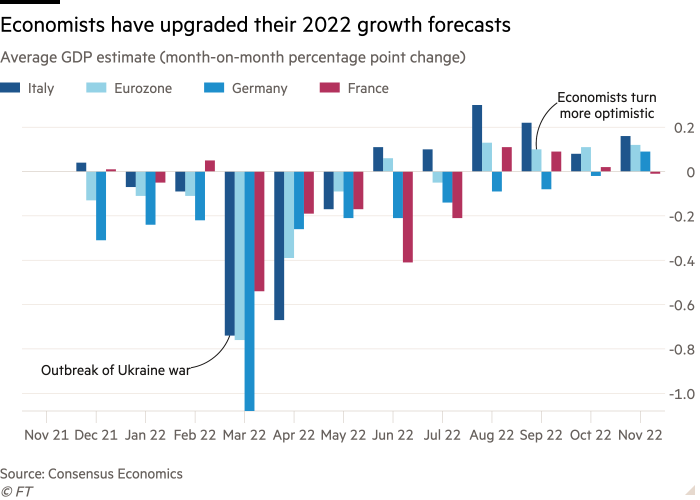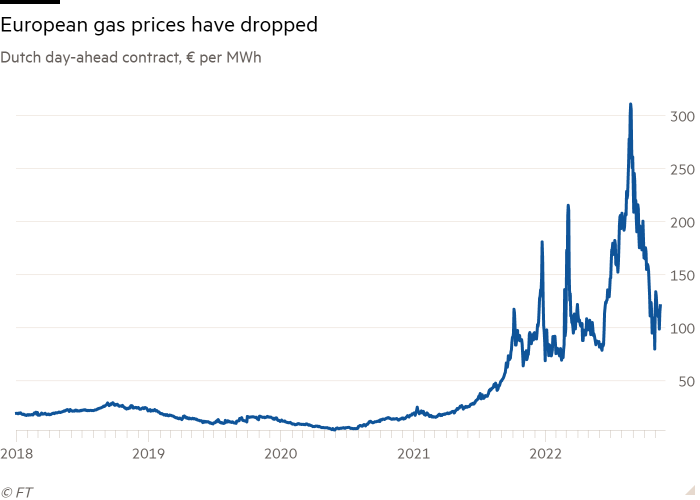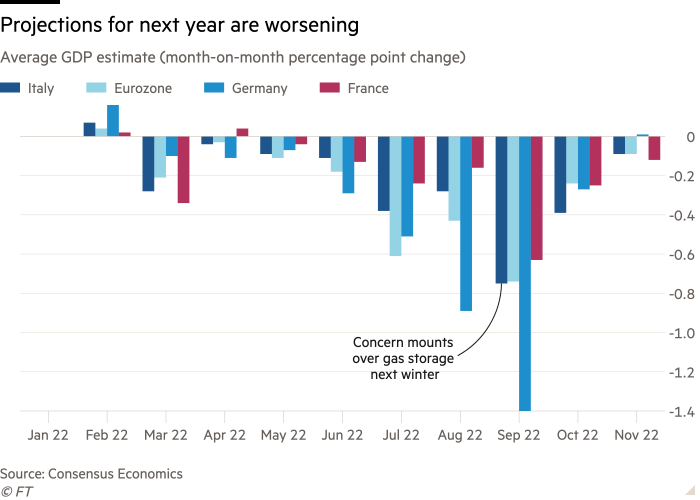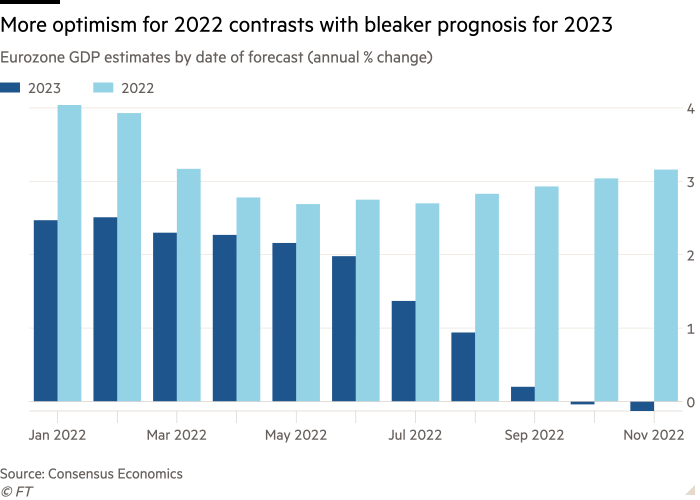The likelihood that the eurozone will fall into a deep recession this winter is receding according to economists who have scaled back their projections as greater fiscal support from governments, lower gas prices and a mild autumn help to improve the bloc’s outlook.
Most forecasters still expect eurozone output to contract in the coming quarters. The European Commission said earlier this month that it expects the economy to shrink by 0.5 per cent in the fourth quarter and by 0.1 per cent in the opening three months of next year — in line with estimates by private-sector analysts.
But the downturn will be more moderate than previously feared. Economists forecast eurozone growth of 3.2 per cent for 2022 as a whole — up from an earlier projection of 2.7 per cent in July, according to the latest compilation of forecasts from Consensus Economics which also reflect the bloc’s better than expected resilience in the three months to September.
‘’Recession in the eurozone is not likely to be as deep as had been feared,” said Susannah Streeter of asset manager Hargreaves Lansdown. “The bloc is set to avoid a full-blown energy crisis this winter.”

Moscow’s shutdown of key gas pipeline Nordstream 1 over the summer fuelled fears that the region would struggle to replace Russian energy sources and led to a surge in gas prices. But one of the mildest Octobers on record has meant households and factories are using less power, helping to keep gas storage facilities close to full capacity.
In the first week of November, gas consumption in the eurozone’s three largest economies — Germany, France and Italy — was down 30 per cent from the 2017-2021 average, according to ENTSO-E data.
In September, Holger Schmieding, chief economist at Berenberg Bank, forecast a 2.1 per cent contraction for the three quarters up to the middle of 2023 based on a gas price of €220 per MWh for this winter and fears of energy blackouts.
Since then, however, the wholesale European gas price has dropped to under €110 per MWh and Schmieding has revised his forecast for the scale of decline to 1.6 per cent. Success in filing gas storage facilities up to full capacity has also eased concerns that industry would face periods without power.

The balance of risks to his forecasts were “now tilting to the upside rather than a downside”, he said.
Goldman Sachs this week changed its prognosis for the same period, expecting a contraction of 0.7 per cent, down from a previous forecast of a 1 per cent fall in output.
Lower gas prices, a reduced risk of energy rationing and extra fiscal support from governments pointed to “a shallower recession”, said Sven Jari Stehn, chief European economist at Goldman Sachs.
Eurozone output expanded 0.7 per cent in the second quarter of this year and 0.2 per cent in the third. The resilience so far meant there would be more “carry over” of economic activity into this winter, said Silvia Ardagna, chief European economist at Barclays.
Ardagna forecast a 1.3 per cent peak-to-trough decline in gross domestic product between the current quarter and the third quarter of 2023, up from an earlier estimate of 1.7 per cent.
“Gas storage is high enough that there is now little risk of outright rationing this winter,” said Andrew Kenningham, economist at Capital Economics, adding that the recovery in the car sector had been stronger than anticipated.
Melanie Debono, economist at Pantheon Macroeconomics, also upgraded her forecast to a “shallower recession” partly because of milder winter weather.
However, economists are becoming increasingly gloomy about the outlook for next winter and now believe eurozone output will shrink 0.1 per cent in 2023 — a sharp downgrade from the 2.3 per cent expansion expected in March, shortly after Russia invaded Ukraine.

Economists worry that, with Russian gas supplies set to remain limited, it will be much harder to refill Europe’s storage capacity for next winter.
Goldman Sachs has downgraded its forecasts for next year overall — along with early 2024.

It will also take time for the fall in wholesale energy prices to filter through to consumers. “Any recovery is likely to be sluggish and drawn out,” said Paul Hollingsworth, chief European economist at BNP Paribas.
Axa chief economist Gilles Moec warned consumer spending would be “mechanically” hit by high inflation, which came in at a fresh record high of 10.6 per cent in October. “Possibly [this winter will be] less dire, but we’re still on our way to a painful recession in my books.”
Charts by Rafe Uddin
Read More:Eurozone edges away from risk of deep winter recession
2022-11-20 05:01:26
